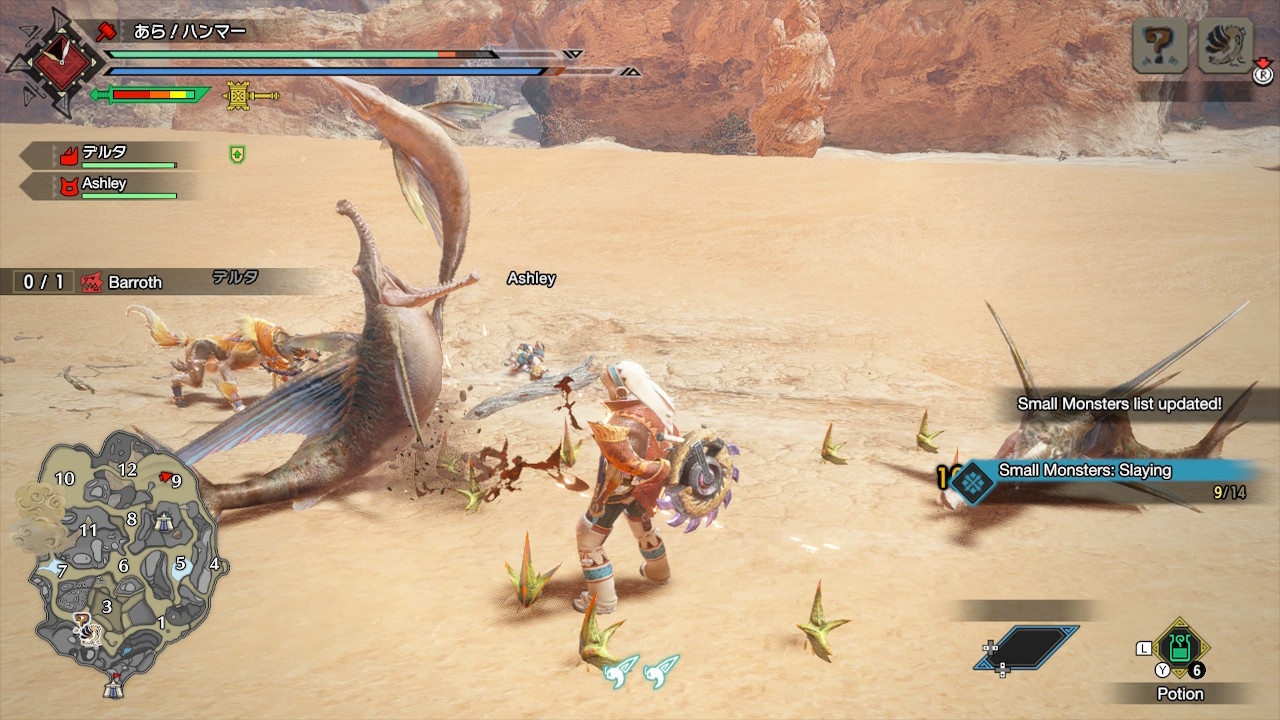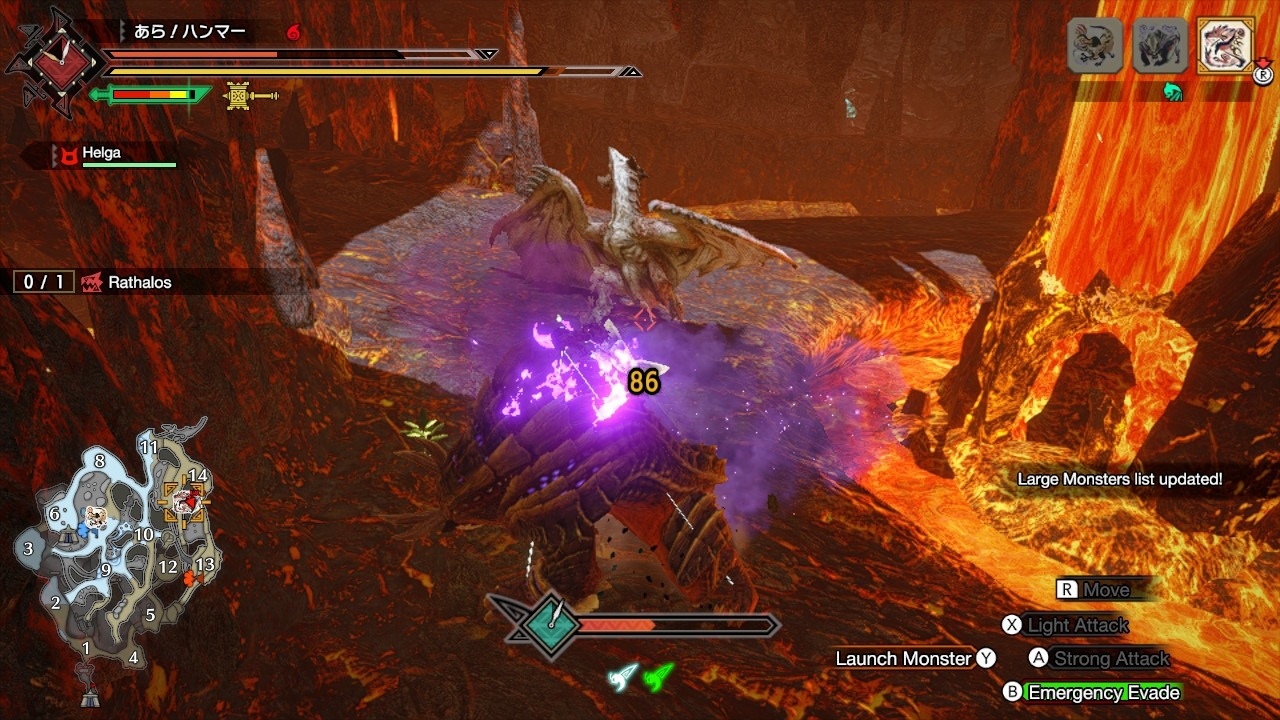The Monster Hunter series has been kicking since the PlayStation 2, though most people’s introduction to the series has been over the past several years, somewhere between Monster Hunter 4, World, Generations, or even the very focus of this review: Monster Hunter Rise.
Monster Hunter hadn’t changed all that much until the release of World, and many of the mechanics and quality of life changes introduced in World have been further refined in Monster Hunter Rise. The open maps, the ability to ride monsters, the new Wirebug mechanic, and the new Palamute companions are all derived from features introduced in Monster Hunter World — and they’re all better here in Rise.
Capcom have successfully implemented the smoothness of World without sacrificing the faster gameplay and vibrant visuals of the mainline games, ultimately providing an experience that both long-time hunters and newcomers to the series can get into and enjoy on their own terms.
Monster Hunter Rise Review: Rise to the Occasion
Monster Hunter Rise‘s hunts are split between Village Quests and Hub Quests, with the former only being available as a solo hunter and the latter available for online play.
If you’ve avoided the series all this time because of its supposed difficulty, you’ll be happy to hear Village Quests are some of the easiest in the entire series. I say this as someone who played Monster Hunter Portable 3rd a ton, which was the previous king of easy. Monster Hunter: Rise‘s Village Quests are accessible to pretty much every skill level, and they are easier than those in Portable 3rd.
If you’re a hunter who’s been at it a long time, though, hearing that Village Quests are so easy might not be such good news. Village Quests have always been the least difficult of the two types, but here, they really present no challenge to seasoned hunters through Rise‘s relatively short story.
Hub Quests are the real meat of Monster Hunter Rise, with the quests found in the Gathering Hub being more plentiful and offering much more challenge than their Village counterparts.
You can take on Hub Quests solo or in a party with up to three other players, just as Monster Hunter is meant to be played. Seriously, you will have a lot more fun with friends or even other random players. It’s the nature of the game!
The current lineup in Monster Hunter Rise is a very reasonable total of 61 monsters, with 35 of them being larger monsters and nine of those being brand new to the series. Facing old foes such as Basarios, Ratholos and Rathian, and Tobi-Kadachi is smoother than ever; and slapping new monsters such as Bishaten and Somnacanth is full of surprises. (I really like Somnacanth, what an annoying cutie. Float on, little angel.)
Open maps were introduced in World and are present here, albeit at a smaller scale. There are fewer materials to be picked up on the map at large; instead, there are a number of other goodies to pick up on your way to your targets.
How Endemic Life works has been altered, and they are now an integral part of gameplay. There are multiple types, too, making them the stars of the show when traversing a map.
“Ensnaring Life,” such as Flashflies, Tricktoads, and Echobats, can be interacted with on the spot to trigger their effects like emitting a bright flash to stun monsters, acting as a decoy in combat, or even sputtering explosive scales to deal damage. You’ll be keeping an eye open for these sorts of Endemic Life mid-combat.
“Temp Buffer” Endemic Life, such as Vigorwasps, Cutterflies, and Wirebugs can give temporary stat increases, a temporary extra Wirebug, or heal.
“Permabuffers” are creatures called Spiribirds that increase your stats until the end of a quest, with caps set by the Petalace you have equipped. These are handy to pick up before you take on a monster to give you that little extra oomph you’ll probably need.
Not last and definitely not least, “Hunting Helpers” are the big boys in the Endemic Life spectrum. These are another entirely new feature, and there are a lot of them. Hunting Helpers can be found all across a map and used during specific quests. Some heal, some function as caltrops, some lure monsters, inflict status effects, or even allow you to instantly mount and ride a monster.
The new focus on Endemic Life is enjoyable and in some ways makes the game feel more arcade-y than its predecessors, as different routes to your target yield different Endemic Life to pick up for stats or to pick up and use on the hunt.
This arcade feeling is compounded by how fast you can get around the map. The Palamute gets you around quickly, but even foregoing the Palamute and bringing two Palicoes along, or just a Palico in multiplayer, and Wirebugging your way around is relatively expedient.
Though the Wirebug controls take some time to get used to, once you’ve grasped their controls, you can maneuver through the heights of the game’s five hunting maps with ease. That’s not the best part of these new little helpers, though: Wirebugs are actively used in combat in Monster Hunter Rise to both dodge and attack.
Each of the game’s 14 weapon types has two Wirebug attacks in their arsenal at a time. As a hammer main (sorry, not sorry), these attacks add just the right combination of mobility, damage, and insanity to my arsenal to make them worth using Wirebug charges for almost perpetually. Which of course, I use a Palico with Summweon Endemic Life even in multiplayer to complement so I usually have three charges.
Did I mention how incredibly awesome Wyvern Riding is? Instead of mounting monsters and clobbering them in the head like you do in Monster Hunter World, here you mount and take control of monsters to take part in what I can only call mini kaiju battles.
Each large monster has its own moveset and movement speed, and each one feels amazing to take control of and tear into other large monsters with. Any time there’s a turf war between large monsters, which you can actually trigger yourself using certain Hunting Helpers, you can bet you’ll be Wyvern Riding soon enough and loving it.
There’s so much to say about the game I didn’t touch here, but there is one last facet to comment on that won’t ruin any surprises: the look and sound of Monster Hunter Rise.
Despite being a slight graphical downgrade from Monster Hunter World, Monster Hunter Rise is wonderfully vibrant in both graphical and sound design.
Reminiscent of Yukumo Village from Portable 3rd and later in Generations, Kamura Village is distinctly Japanese-styled, bright, and inviting. There’s not a ton going on in Kamura, but what’s there is endearing and full of charm. Let’s not get into how good the Gathering Hub theme, Brave Hunters, is and how you should just set all the village music to it.
The hunting maps themselves are also vibrant between the landscapes themselves and the creatures that inhabit them. The music tracks that play while you’re exploring are good, but the combat themes are on an entirely different level, even by Monster Hunter standards. When you’re fighting Mangamalo or Nargacuga or any other monster with its own theme, you feel like the hunter. It’s really something special.
Monster Hunter Rise Review — The Bottom Line

Pros
- A pile of quality of life changes from previous entries that all just work
- Fantastic sound design from music to monster cries
- Beautiful visuals, particularly for the Nintendo Switch (Capcom magic)
- Minimal load times
- A large roster of monsters to best off the bat
Cons
- As it stands, the story is unfinished
As someone who started with Monster Hunter on the PSP with Monster Hunter Freedom Unite, it’s been a treat to play through the series over the past decade and see it grow into what it is today. Though I will admit I’m one of those who didn’t enjoy World as much as most, in large part due to its slower pace.
Initially, I’d planned on giving Monster Hunter Rise a (very) slightly lower, just because of its relatively easy difficulty and the fact the game’s story is not quite finished on release. That would be doing it a disservice, however.
Some had a bit of a fit that the game’s story isn’t finished upon release, and boo to Capcom on that, but I don’t see it as a reason to dock the game by a point considering the total lack of emphasis on story in the Monster Hunter series and how little it matters.
The game will be receiving patches and events like in World to add new monsters, as well as to finish the story up over the coming months, and considering the amount of content already in Monster Hunter Rise through both Low and High Rank I simply see no reason to slap it with a lower score.
Monster Hunter Rise as it stands might be one of the easiest games in the series, but it’s also one of the most flexible and ultimately satisfying in each and every regard, and for that, it deserves full marks.
[Note: Capcom provided the copy of Monster Hunter Rise used for this review.]









Published: Apr 6, 2021 01:46 pm